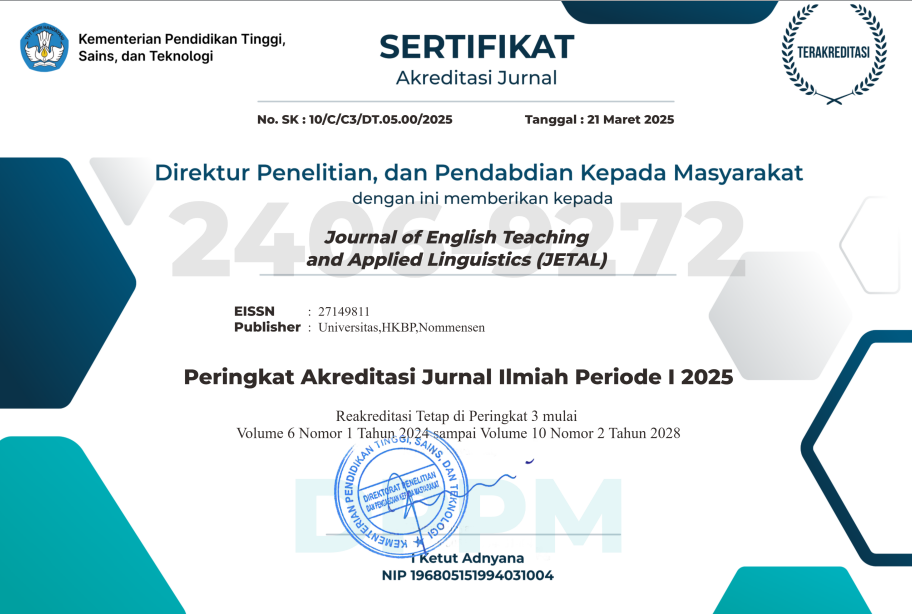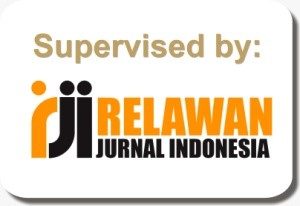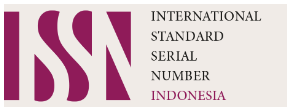CONTENT ANALYSIS OF ENGLISH TEXTBOOK “INTERACTIVE ENGLISH” USED IN FIRST GRADE JUNIORHIGH SCHOOL IN 2013 CURRICULUM
Abstract
The objectives of this study are to find out the suitability of impressionistic and in-depth analysis in the textbook entitles "Interactive English” used for the seventh grade of Junior High School. This research is conducted by applying descriptive qualitative. The data was collected by documenting the content materials on the textbook and it was analyzed by using Cunningsworth's theory. The result showed that an English textbook entitle “Interactive English" fulfilled the criteria proposed in Cunningsworth's theory concerning the impressionistic textbook analysis with score 96% and in-depth textbook analysis with the summative score 87%. From those summative scores, the textbook was categorized as a good enough textbook and suitable enough to use as media in teaching and learning process.
[W81]Rata kanan dan kiri harus sesuai dengan tubuh artikel
References
Akbar, Rizky. 2016. Analysis of Selected Eleventh Grade English Textbook.
Universitas Pendidikan Indonesia: Bandung.
Cunningsworth, Alan. 1995.Choosing your Coursebook. New York: Macmillan.
Darrin, Abu 2014. An Analysis of English Textbook for First Grade of Senior High School Published by Putra Nugraha. Universitas Pendidikan Indonesia: Bandung.
Depdiknas. 2008. PengembanganKurikulumPada Pendidikan Kesetaraan. Jakarta: BalaiPengembangan Pendidikan Non-Formal dan Informal.
Fraida,Dubin& David,Eskey. 1986.Theoretical Foundation in Teaching Reading for Academic purpose. Massachusetts:Addison-Wesley Publishing Company.
Harmer, Jeremy. 2001. The Practice of English Language Teaching. London: Longman.
Hutchinson, T.,&Torres, E.1994. The Textbook as Agent of Change. ELT Journal.
Krippendorff, Klaus. 2004. Content Analysis, an Introduction to Its Methodology. University of Pennsylvania: Sage Publications, Inc.
Maxwell, Joseph. 1996.Qualitative Research Design, An Interactive a Hal Roach. California: Sage Publication, Inc.
Muslich, Mansur. 2010.Textbook Writing. Jakarta: Ar-Ruzz Media
Nunan, Davis. 2004.Task-Based Language Teaching. New York: Cambridge University Press.
Prasojo, Arif. 2014. The Analysis of English Textbook Pathway to English. Universitas Islam Negeri Jakarta: Jakarta.
Richards, Jack. C. 2001. Curriculum Development in Language Teaching. Cambrige: Cambridge University Press.
Rost, Michael. 2002.Teaching and Researching Listening. Great Britain: Personal Education Limited.
Sari, Trisyana. 2015. An Analysis of the Relevance of English Material in a Textbook Entitled Bright for Junior High School Grade VII Published by Erlangga. Universitas Negeri Surabaya: Surabaya.
Setiawati, Dian. 2015. Content Analysis of Student Book “When English Rings a Bell”. Universitas Negeri Semarang: Semarang.
Sheldon, Leslie. 1968. Evaluating ELT Textbook and Material. ELT Journal. Oxford University Press.
Sitorus, G. S., &Sipayung, K.T. 2017. An Error Analysis of Using Phrases in Writing Recount Text at Tenth Grade in Parulian 2 Medan. A Journal of Culture, English Language, Teaching and Literature,18,80-88.
Tarigan,Henry.G.1986. TelaahBukuTeks Bahasa Indonesia. Bandung: Angkasa.
Wahyuni, Sry. 2016.Curriculum Development in Indonesia Context. ELT Journal Vol.10.
Yanto, Heru., E. in 2016. A Content Analysis on “Think Globally Act Locally” English Textbook in Curriculum 2013 for the Ninth Grade Student of Junior High School Published by Kementrian Pendidikan dan KebudayaanRepublik Indonesia”. Institut Agama Islam Negeri Surakarta: Surakarta.
Authors retain copyright and grant the journal right of first publication with the work simultaneously licensed under a Creative Commons Attribution-ShareAlike 4.0 International License (CC BY-SA 4.0) that allows others to share the work with an acknowledgment of the work's authorship and initial publication in this journal.
Authors are able to enter into separate, additional contractual arrangements for the non-exclusive distribution of the journal's published version of the work (e.g., post it to an institutional repository or publish it in a book), with an acknowledgment of its initial publication in this journal.
Authors are permitted and encouraged to post their work online (e.g., in institutional repositories or on their website) prior to and during the submission process, as it can lead to productive exchanges, as well as earlier and greater citation of published work (See The Effect of Open Access).






